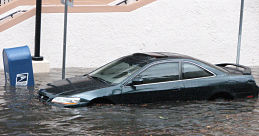 Water can destroy a car’s interior, electrical system, and engine. While you might not be able to save your vehicle if it’s fully submerged under water, there’s hope if the water didn’t go more than halfway up the wheels. In any case, here are the steps you need to take if your car floods.
Water can destroy a car’s interior, electrical system, and engine. While you might not be able to save your vehicle if it’s fully submerged under water, there’s hope if the water didn’t go more than halfway up the wheels. In any case, here are the steps you need to take if your car floods.
Don’t Start the Car
The first and most important step you need to take when your car floods is to remember what you shouldn’t do. Do not attempt to start your car. While you might want to give it a try to see if it still works, if there’s any water in the engine, starting it could damage it beyond repair. If there’s any doubt, your best bet is to call a tow truck and have your car taken to a mechanic.
Call Your Insurance Company
While collision insurance typically doesn’t cover flood damage, you might have coverage through your comprehensive insurance. Therefore, it’s a good idea to call your insurance company and find out what steps you need to take if you need to make a claim. If your vehicle flooded because of a natural disaster, such as a flood or hurricane, your insurance company will likely be dealing with hundreds to thousands of claims, so it’s a good idea to start the process as soon as possible.
Determine the High-Water Mark
Next you’ll need to see if you can figure out how high the water got on your vehicle. If the water was dirty, it’s usually very easy to see exactly where it stopped based on the line of mud or debris in your vehicle. However, if it was clean water, it might be hard to tell. In this case, feel the dampness of the upholstery or trim and look inside the headlights or taillights to give you a clue. Keep in mind that many insurance companies will consider a car totaled if the water reached the bottom of the dashboard.
Start Drying the Interior
Mold will start to grow on the parts of your vehicle that got wet, so you need to start drying out the interior as quickly as possible. Begin by opening all the windows and doors to let it air dry. You can also use towels to soak up any water from the floors or seats. However, you’ll likely want to replace anything that got wet, including upholstery, seat padding, carpets, door panels, and floor mats.
Check the Fluids
Once you lift the hood, you’ll get a better idea of the extent of the flood damage. You’ll want to pull the oil dipstick out and check it for water droplets. Also, check for water in the air filter, fuel system, and power steering, brake, and coolant reservoirs. If you see signs of water in any of these locations, your best option is to have your vehicle taken to a mechanic for professional help.
While a flood can cause disastrous damage to a vehicle, with these steps, you might be able to salvage your flooded car.
This photo, “South Beach flood,” by maxstrz used under CC BY 2.o. “South Beach flood ” is licensed under CC BY 2.0 by Gay Family Kia.


 Warranties include 10-year/100,000-mile powertrain and 5-year/60,000-mile basic. All warranties and roadside assistance are limited. See retailer for warranty details.
Warranties include 10-year/100,000-mile powertrain and 5-year/60,000-mile basic. All warranties and roadside assistance are limited. See retailer for warranty details.